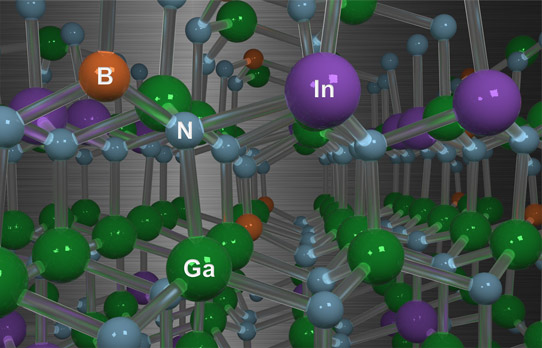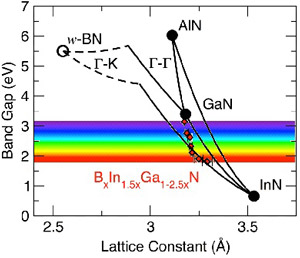- News
22 November 2017
University of Michigan predicts incorporating boron in InGaN increases LED efficiency at high power
© Semiconductor Today Magazine / Juno Publishing
Despite revolutionizing illumination, even top-of-the-line nitride LEDs are far from their maximum efficiency when operating at the high power needed for lighting applications. Logan Williams and Emmanouil Kioupakis at the University of Michigan have recently performed calculations that show that incorporating boron into the indium gallium nitride (InGaN) active region of nitride LEDs could be a step towards realizing higher efficiency at high power (‘BInGaN alloys nearly lattice-matched to GaN for high-power high-efficiency visible LEDs’, Applied Physics Letters 111, 211107 (2017)).
Devices using InGaN/GaN face two major challenges to increasing efficiency. The first is efficiency droop, whereby LEDs are less efficient when operating at high power. The drop-off in efficiency is attributed primarily to the non-radiative Auger recombination mechanism, in which an electron and a hole recombine and excite a third carrier (either an electron or a hole) instead of emitting a photon. Auger is an implicit property of the material and cannot be directly eliminated, but a simple solution is to have a larger active region to spread carriers out over a greater volume. But this runs into the second problem — InGaN is not lattice-matched to GaN and growing thicker wells without forming defects is impossible.
Kioupakis and Williams reckon that they have found a way around both of these problems by studying the properties of co-alloying InGaN with boron. Using first-principles calculations and high-performance supercomputers at the National Energy Research Scientific Computing (NERSC) Center (a Department of Energy Office of Science User Facility, supported under contract no. DE-AC02-05CH11231), they found that incorporating B and In atoms into GaN in a 2:3 ratio yields BInGaN alloys that are nearly lattice matched to GaN. For small indium fractions, the mismatch was as low as ±0.25%, allowing the possibility of growing thicker active regions that are more efficient at high power.

Picture: Crystal structure of BInGaN alloy. Using atomistic calculations and high-performance supercomputers at the NERSC facility, Logan Williams and Emmanouil Kioupakis of the University of Michigan predicted that incorporating boron into the InGaN active region of nitride LEDs reduces or even eliminates the lattice mismatch with the underlying GaN layers while keeping the emission wavelength about the same. Lattice matching enables the growth of thicker active regions and increases the efficiency of LEDs at high power. (Image credit: Michael Waters and Logan Williams).
They also found that the electronic properties are conducive to creating LEDs in the desired visible wavelengths. Adding boron to InGaN does not significantly affect the character of the band edges, which remain primarily N and In states. This allows the energy bandgap of BInGaN to be tuned throughout the 3.39-1.75eV range, which includes the entire visible spectrum. This is in contrast to BGaN whose bandgap increases (away from the visible region) as a function of boron content and even becomes indirect for high boron concentrations.
 Picture: Bandgaps versus in-plane lattice constant for wurtzite nitride semiconductors. The BInGaN alloys predicted in this work are approximately lattice match to GaN while their gaps span the entire visible range. Image from Applied Physics Letters 111, 211107 (2017), copyright AIP.
Picture: Bandgaps versus in-plane lattice constant for wurtzite nitride semiconductors. The BInGaN alloys predicted in this work are approximately lattice match to GaN while their gaps span the entire visible range. Image from Applied Physics Letters 111, 211107 (2017), copyright AIP.
The remaining question is: “Can the desired alloys be grown experimentally?” While the researchers do not have conclusive evidence, their calculations show that it is likely at least for BInGaN alloys with lower amounts of boron. By studying the thermodynamic properties of both BInGaN and BGaN, they found that the temperature required to incorporate boron into InGaN is 1.5x lower than the temperature necessary to incorporate boron into GaN. Since BGaN alloys with boron concentrations of up to ~3% have already been grown experimentally, the researchers estimate that it will be possible to grow BInGaN with up to 4.5% boron concentrations using the techniques already in use. Nevertheless, experimental challenges remain regarding the growth temperature and the appearance of secondary phases that need to be further investigated.
Increasing the efficiency of LEDs could drastically reduce electricity usage for lighting, which currently comprises about 20% of the USA’s total electricity usage. The researchers say that the BInGaN materials predicted in their study would allow for thicker active regions to be grown in common LED materials using techniques that are already widely used, taking a step in the right direction for overcoming the two major efficiency challenges currently faced by LEDs.
The work was supported by the Designing Materials to 282 Revolutionize and Engineer our Future (DMREF) Program under Award No. 1534221, funded by the US National Science Foundation (NSF).
LEDs InGaN Efficiency droop Boron nitride
http://aip.scitation.org/doi/full/10.1063/1.4997601


